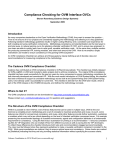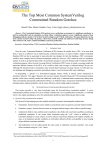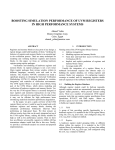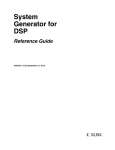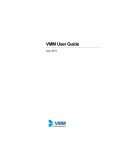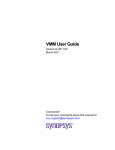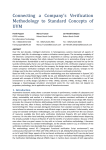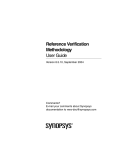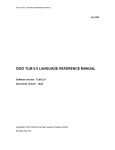Download Paper - Verilab
Transcript
The Smartphone Approach to HVL Test Benches Techniques to boost debug capabilities of your team Alex Melikian Anders Nordstrom Verilab Inc. Montreal, Canada [email protected] Verilab Inc. Ottawa, Canada [email protected] Abstract—The emergence of advanced Hardware Verification Languages has created new challenges for ASIC/FPGA development teams. The expertise and skills needed for verification using HVLs are significantly different to those of the traditional paradigms in design. This paper offers solutions, techniques and practices for verification engineers to allow those unfamiliar with HVL technologies to be able to use, fine tune, and debug their environments intuitively. Such an HVL environment may be compared to a smartphone: vastly complex on the inside, but intuitive and easy to use on the outside. The benefit from applying these solutions and practices will enable the debugging capability of the entire team, and not just those specializing in HVL development. INDEX TERMS— HVL, CODING PRACTICES. SYSTEMVERILOG, OVM, DEBUG, I. INTRODUCTION A development team responsible for a new project is often divided into two sub-teams: one handling design tasks and the other handling verification tasks. Inevitably, a verification engineer will discover an issue necessitating the attention of a designer. After consulting and communicating with the designer about the bug, the verification engineer awaits modifications to correct the issue. In an ideal world, the verification engineer expects the designer to re-run the failing test and perhaps run a few other iterations with different randomization seeds to assure the modifications are valid. However, in most cases the verification engineer finds the designer returning to their desk stating a fix is made and requests the verification engineer re-run the test. The verification engineer feels the designer’s modification may still contain flaws, or worse, have broken previously functional features. Thus the designer should re-run the simulations. The design engineer feels he does not have the adequate experience or skill to understand modern day HVL based environments. In addition, it is the verification engineer who knows best how the test cases behave, in addition to how parameters and constraints are to be set to simulate the feature adequately. The increasing divergence of design and verification skill sets has created an evolving gap in the skill set between verification and design engineers. Though they both work on the same set of requirements and objectives, designers focus on clock cycle behavior whereas verification engineers focus on object-oriented classes and randomized test cases. How can this gap be bridged in order to boost the debugging capability of the team and deliver a bug-free product faster? II. PHILOSOPHY BEHIND THE SOLUTION The development team does not have to be confined to members who only exclusively do design or verification. Verification engineers can make their environment userfriendly, easy to use and intuitive. Let’s take the example of smartphones: a highly sophisticated, advanced technology, yet highly popular with consumers regardless of their level of technological understanding. This phenomenon exists because smartphones are produced to be so intuitive, concise and userfriendly, that users don’t bother reading the manual, despite the highly complex technology inside the product. This philosophy is the central theme of the solutions and proposals presented here. Despite the high sophistication and complexity of HVLs and environments, they can, nevertheless be tools created in a manner many can utilize, regardless of a user’s level of experience with them, as some publications have recognized [1][2]. Ideally, an HVL environment should be built in a way to have three ‘easy’ characteristics: - easy to use test cases - easy to debug with environment - easy to maintain verification environment. The solutions we propose concentrate on the first two ‘easy’ characteristics, whereas the last one is a subject for future work and publication. Note: All the examples in this paper use SystemVerilog as the HVL along with OVM [3] as the methodology library and Questa [4] as the simulator. However, the concepts presented in this paper can be applied with any HVL language, methodology and simulator. III. EASY TO USE TEST CASES The solution begins with practices involving both code and file structure of test cases. The following practices will allow members of the development team to easily find test case files, and be able to modify configuration values without prior knowledge of the HVL code. A. File Naming Convention The first step for the HVL coder is to use filenames that are intuitive to understand for the files containing source code of test cases. The following is a bad example of test case file names in a directory tree: testcases> ls tc01.sv tc02.sv tc03.sv This bullet-form sequence description of the test case can be used in the test case HVL code for logging. By doing so, the actions of the test case executed by the environment are published to the user, and recorded in the log file. Hence, portions of the log file of the above documented test case can appear as follows: Fig. 1: Bad test case file naming convention Even though these numerically listed files may be documented and mapped out in a verification plan, it still obliges users to go through an extra step to understand their meaning. The following shows a better convention of naming test files in a more lexical fashion: testcases> ls tcTxSanity.sv tcRxSanity.sv tcLoopback.sv Fig. 2: Good test case file naming convention With the above convention, it is intuitive to correlate which files are associated with which specific test case. Designers, or verification engineers who did not author these test cases, will easily pinpoint the suitable file to edit in order to carry out their desired simulation. It should be mentioned that well structured compilation and invocation scripts prioritizing ease of use and abstraction from implementation details should be employed. This allows users to easily compile and execute test cases without the need for understanding details of the test bench or the tools they run on. B. Test Case Stages Now that test case files have been made easy to locate, the next practice makes it easy for a user unfamiliar with the test case to understand what exactly it is doing in the running process of the simulation. To do this, the suggested practice uses a combination of using information in a verification plan, and mapping them into the log messages of the test case. Each test case is a set of actions to verify a singular or multiple characteristics of a feature (or set of tightly related features) in a design. These test cases are determined beforehand and documented in a verification plan. In the verification plan, the sections listing the test cases typically describe the sequence of actions involved, either elaborately or in bullet form. For example, take the situation of a test case verifying loopback functionality of a packet router. The following may be published in the verification plan: Loop-back Test Case 1) Program TX configuration registers 2) Program RX configuration registers 3) Activate Loop-back 4) Send TX traffic 5) Wait 3 ms 6) Check no packet losses Fig. 3: Typical test case description in a verification plan [20us] TC Stage 1) Program ... [30us] TC Stage 2) Program ... [100us] TC Stage 5) Wait 3 ... [3100us] TC Stage 6) Check TX config regs RX config regs ms no packet losses ... Fig. 4: Test case printing of stages documented in verification plan Print statements generating messages in a log as in Fig. 4 can help a user understand what is happening and when it is happening in the simulation. They also employ an appropriate marker (e.g. “TC Stage”) to make it easier to search in a large log file. Since the actions of the test case are documented, designers know what to expect in the simulation, they can correlate the actions exerted by the test bench on the design and determine when they are happening with the corresponding printed messages. Hence designers need not understand the test case HVL code, but rather consult the verification plan and search the log file (or simulator console) for the corresponding stage messages. C. Accessible & Intuitive Configuration Knobs The last piece in this set of solutions to make test cases easier to use is the structure and coding style of test case configuration parameters (often dubbed knobs). A cornerstone feature of HVL languages is the definition and subsequent control of variables in a constrained random manner. This capability of randomization and defining constraints is applicable to any test bench variable at any level or scope. This defined set of parameter constraints is the essential interface for a user to control the behavior of the test case. A good practice which make test benches more user friendly is to structure the code and files dealing with knobs in such a way that makes it easy to find, intuitive to understand and easy to edit. Due to the nature of how configuration objects are spread out in a test bench, it can be tempting for the HVL programmer to keep related constraints spread in multiple files or sections of a file. However, it is much easier for a user to have these constraints concentrated in one easy-to-find area. Though additional effort is necessary (i.e passing down configuration values in hierarchy) on behalf of the HVL programmer, the pay-off is test cases that are made easy to tweak or adjust for the user. Two approaches can be used allowing constraints to be structured in a fashion that make them easy to locate. One of the approaches is to put them at the top of the test case file: it would be the first segment of code a user would interface with. Another method involves using a separate file, consistent with a more lexical file naming convention discussed earlier. For each test case file, a file under the same lexical name with the suffix “_config” or “_constraints” can be used, as follows: testcases> ls tcTXsanity.sv tcTXsanity_constraints.sv tcLoopback.sv tcLoopback_constraints.sv Fig. 5: Test case constraint file structure The contents of a constraint file may appear as follows: class TcLoopback_cfg extends TcBase_cfg; rand integer test_pkt_cnt; [...] constraint tcLpbck_cnstr { test_pkt_cnt inside {[20:25]}; [...] } endclass; Fig. 6: Example test case constraint file With the constraint-related code structured and defined in a specific, easy-to-find location, designers can be encouraged to modify the code thus modifying the behavior of the test case to their requirements. Designers need not learn and understand the entire HVL language, but only the small subset of keywords and syntax constructs related to defining constraints. Like all other learning experiences, practice is needed. However this reduced subset of keywords can be picked up quickly, even with no HVL experience. Hence, designers can start off using a test case and the debugging process by using narrow constraints, and gradually widening them and get better coverage. Good commenting on behalf of the HVL programmer is always helpful in describing the intent and function of the code. The code dealing with parameter constraints is no exception, especially if verification engineers want to encourage designers to use them. For example: class TcLoopback_cfg extends TcBase_cfg; // test_pkt_cnt: # of packets to lpbk’ed in DUT rand integer test_pkt_cnt; [...] constraint tcLpbck_cnstr { // cnstrnt of # of packets to be lbk’ed in DUT test_pkt_cnt inside {[20:25]}; [...] } endclass; Fig. 7: Test case constraints file with appropriate commenting The practices mentioned above help designers feel more comfortable tinkering and fine-tuning HVL code to their requirements, regardless of their level of experience. The next section describes how more can be done related to parameters and constraints, making the environment more intuitive to use. IV. EASY TO DEBUG WITH ENVIRONMENT The practices in this section show how test bench messages and presentation of additional information can be implemented to be easily understood by any user, and aid in the autonomous debugging of the design. Once again, these practices consider the user of the environment will have little to no prior experience with any HVL. A. Feedback of Randomized Parameters In the previous section, we discussed how HVL code could be structured to make test case knobs easier to access and edit. Once constraints are set however, a means of providing feedback to the user on the generation of these knobs is needed, confirming that desired results were generated by the constraints solver. This feedback is very helpful, particularly to designers new to constrained-random generation and the related HVL code syntax. A simple method of providing this feedback is to provide, at the beginning of simulation, an easily readable, well formatted printout of all relevant test bench and test case knobs that are subject to constrained randomization. The following is an example of a printout of test case knobs, using the above mentioned loopback example: ----------------------------------- Test Bench Configuration ----------------------------------Test Case: ---------Tx Packets to inject: 25 Tx Rate: 70 Mb/s Max Packet Size: 1576 Min Packet Size: 64 [ ... ] ---------------------------------- Fig. 8: Test case configuration knob printing With this formatted printout, the user can easily and quickly get feedback on the results of constraints defined to the test case knobs. The HVL programmer should carefully construct the code, providing this feedback. The example code in Fig. 9 would produce a printout similar to Fig. 8: class TcBase_cfg; rand bit : DUT_Lpbk_mode; [ ... ] function void print_knobs(); $display(“---------------------“); $display(“—Test Bench Config --“); $display(“---------------------“); $display($psprintf(“DUT Loopback Mode: %s”, (DUT_Lpbk_mode)?”ON”:OFF)); [ ... ] print_knobs_extra(); endfunction; virtual function void print_knobs_extra(); $display(“---------------------“); endfunction; Extra care should be given for messages related to transactions, as they are the most commonly searched for and analyzed element when debugging. A transaction or sequence item is typically printed with all data as it is passed between components of the test bench, e.g. from sequencer to driver or when a monitor publishes a transaction. The fields to print and their format are declared using ovm field macros in the transaction class. To print a specified field or not is controlled by OVM_ALL_ON or OVM_NOPRINT as shown in Fig. 10. class digrf3_transaction extends ovm_transaction; int bit [7:0] bit int time time endclass; Fig. 9: Configuration knobs printing code The code in the above figure uses a structure that creates a classification of environment parameters. Typically, parameters are defined either from a common test bench object holding data applicable to many or all test cases, or from an object with parameters specific to a single test case only. This typical categorization is reflected in the above code, as classes defining configuration parameters for the test case are often a sub-class of a base class containing test bench parameters. As we can see in the code sample of Fig. 9, the base class defined the print_knobs() function and added print statements of commonly applicable test bench parameters. This function has a call of another printing related function print_knobs_extra(). It is structured this way to allow its sub-classes, containing test case specific configuration knobs, to printout the additional knob information as well, with overriding code from the HVL programmer. OVM provides phases where such configuration printing functions can be called: the “start_of_simulation()” phase would produce the printout at the beginning of simulation. B. Clarity and Detail in Messages Care should always be employed with error, log or debug messages to ensure clarity. Ambiguous, unhelpful messages will not help the user or designer debug a simulation on their own. Many tools are available to assist in establishing a hierarchical and clear system of messages to help the user efficiently debug, such as the verbosity control of messages. The right amount of information needs to be present in the log file: not too much to overwhelm the user but enough to pinpoint the area of investigation. Using the OVM predefined verbosity levels OVM_LOW, OVM_HIGH and OVM_FULL together with the macro `ovm_info and guidelines for what messages to print at each verbosity level achieves this goal. Each verbosity level is used for different intents and purposes. At OVM_LOW print one line of information per transaction. Enough information should be displayed to show the flow of items through the test environment. Used mainly for regression to help identify where an issue occur. OVM_HIGH prints out each transaction with data once. Mainly used when debugging failing test cases. OVM_FULL may be very verbose and is used when debugging OVM verification components. m_data_size; m_data[]; m_sleep; m_delay; m_start_time; m_end_time; `ovm_object_utils_begin(digrf3_transaction) `ovm_field_int (m_data_size, OVM_ALL_ON | `ovm_field_array_int (m_data, OVM_ALL_ON | `ovm_field_int (m_sleep, OVM_NOPRINT) `ovm_field_int (m_delay, OVM_ALL_ON | `ovm_field_int (m_start_time, OVM_ALL_ON | `ovm_field_int (m_end_time, OVM_ALL_ON | `ovm_object_utils_end OVM_DEC) OVM_HEX) OVM_DEC) OVM_TIME) OVM_TIME) … endclass: digrf3_transaction; Fig. 10: ovm transaction class with field macros An example of printing a transaction using the ovm_table_printer in a monitor is shown in Fig. 11 with the output shown in Fig. 12. Note the absence of the m_sleep field. class digrf3_monitor extends ovm_monitor; digrf3_transaction c_item; ovm_table_printer printer; … if (ovm_report_enabled(OVM_HIGH)) c_item.print(printer); … endclass : digrf3_monitor Fig. 11: ovm_table_printer used in monitor Declaring the ovm_table_printer in the monitor class and passing the handle to the print() method allows for customization of the output e.g. changing column width. # OVM_INFO @ 2601 ns: ovm_test_top.env.monitor [digrf3_monitor] collected Tx transaction: # ------------------------------------------------------# Name Type Size Value # ------------------------------------------------------# phy digrf3_tran+ phy@23908 # m_data_size integral 32 'd5 # m_data da(integral) 5 # [0] integral 8 'h24 # [1] integral 8 'haf [...] # [4] integral 8 'h16 # m_delay integral 32 'd0 # m_start_time time 64 2558 ns # m_end_time time 64 2601 ns # ------------------------------------------------------- Fig. 12: Example of clear and informative transaction related message Built-in OVM library functions exist to assist in presenting clear information. When creating messages, the HVL programmer can use OVM functions, such as the get_type_name() function, to retrieve specific transaction information instead of simply passing a “this” pointer. C. Transaction Recording and Viewing OVM drivers and monitors connect to the DUT and drive and sample chip signals. They typically have a clock and consume simulation time. This means that it is where designers are going to feel most at home. Designers are used to using waveform viewers for debugging and, by adding transactions to the waveforms, information can be presented in a familiar format. OVM transactions are easy to view as they are already defined in the various test bench components. When field automation macros are used those fields are automatically recorded. As an example, serial protocols especially benefit from this approach since it is difficult and tedious to decode through signal inspection. An example SPI transaction is shown in Fig. 13. class spi_transaction extends ovm_transaction; spi_cmd_enum m_command; bit [7:0] m_dev_addr; bit [4:0] m_reg_addr; bit [15:0] m_data; `ovm_object_utils_begin(spi_transaction) `ovm_field_enum (spi_cmd_enum, m_command, `ovm_field_int (m_dev_addr, OVM_ALL_ON `ovm_field_int (m_reg_addr, OVM_ALL_ON `ovm_field_int (m_data, OVM_ALL_ON `ovm_object_utils_end OVM_ALL_ON) | OVM_HEX) | OVM_HEX) | OVM_HEX) function new (string name = "spi_transaction"); super.new(name); endfunction : new Fig. 13: SPI Transaction declaration In order to record the spi_transaction, a transaction stream to record the transaction into needs to be created. The create method followed by the begin_tr() and end_tr() functions are used for this. In the monitor run() task, the code in Fig. 15 is added in order to create the SPI_TRANS transaction stream which will record items of type spi_transaction. The void functions begin_tr() and end_tr() are part of the OVM library but their implementation is vendor specific. Fig. 14 (bottom): Transaction in waveform window class spi_monitor extends ovm_monitor; spi_transaction c_item; … task spi_monitor::run(); c_item = spi_transaction::type_id::create("c_item"); begin_tr(c_item, "SPI_TRANS"); end_tr(c_item); fork collect_spi_transaction(); join endtask : run Fig. 15: Create Transaction Recording Item The purpose of the dummy transaction stream created in the run task is to make the transaction handle (c_item) available at time 0 so that it can be added to a wave.do file (included after run 0). During the transaction collection phase, create a transaction item for each transaction (and to ensure that the viewed transaction are not just a delta-cycle wide), declare a time variable and assign it to current simulation time on the first posedge of SPI clock and pass the value to the begin_tr() function. This causes the displayed transaction to be shifted in time as seen in Fig. 14. task spi_monitor::collect_spi_transaction(); time start_time; c_item = spi_transaction::type_id::create(“c_item”); … `ovm_info(get_type_name(),"collected SPI transaction:", OVM_HIGH) begin_tr(.tr(c_item), .stream_name("SPI_TRANS"), .begin_time(start_time)); end_tr(c_item); … Fig. 16: Recording a transaction The transaction stream SPI_TRANS is then shown in the waveform starting at the beginning of the SPI transaction and having the same duration as the serial data being received (even though the transaction fields are not available until the end of the transaction). D. Stop on Error Another aspect of efficient debugging is to stop the simulation on the first error rather than waiting for the test case to finish (with potentially multiple errors). One suggested approach is to add the code in Fig. 17 to the end_of_elaboration() method in the test case base class. The code is further encapsulated to allow control via the command-line or in test cases by defining `STOP_ON_ERROR. With this setup, the simulation will stop on the first OVM_ERROR. 2 1 `ifdef STOP_ON_ERROR set_report_severity_action_hier( OVM_ERROR, OVM_EXIT | OVM_DISPLAY | OVM_COUNT); `endif Fig. 17: Enable stop on first OVM_ERROR Continuing a simulation when a call to randomize fails because of a constraint error is likewise not productive. Randomization faults in the OVM library, for example in ovm_sequence_base.svh, are defined as OVM_WARNING so the code in Fig. 17 will not stop the simulation. It must be further extended, as shown in Fig. 18 to achieve this. ovm_top.set_report_severity_id_action_hier( OVM_WARNING, "RNDFLD", OVM_EXIT | OVM_DISPLAY | OVM_COUNT); Fig. 18: Enable stop on Randomization Fault E. Easy Viewing of Class Variables In addition to transactions it is useful to view class method variables, for example in monitors, in the waveform display. However, automatic variables declared inside class methods have a temporary lifetime and can usually not be viewed along side RTL signals. For example, the code in Fig. 19 shows an extract from an SPI monitor where a local variable (access_count), to count the number of accesses to the interface, is declared and used in the collect task. task spi_monitor::collect(); int access_count; … access_count++; … endtask : collect Fig. 19: Class method variable declaration and use It is accessed through a function in the sequencer so functionally it is not needed to make the variable visible. function int get_access_count(); return sequencer.monitor.m_access_count; endfunction : get_access_count Fig. 20: Class method variable access method However, in order to view the variable in the waveform as shown in Fig. 14, the scope of the variable declaration must be moved from the task to a class with a permanent lifetime i.e. a class that extends ovm_component as shown in Fig. 21. Following common coding conventions for class member variables it is renamed to m_access_count. class spi_monitor extends ovm_monitor; int m_access_count; `ovm_component_utils_begin(spi_monitor) `ovm_field_int (m_access_count, OVM_ALL_ON) `ovm_component_utils_end Fig. 21: Class member variable declaration Other variables to consider declaring in the class scope and viewing with the waveforms includes phase indicators, communication markers for start (or end) of frame, and monitor (or driver) state variables. To further help the user of the test bench, these variables should be automatically added to the waveforms through scripts when a simulation is run in interactive GUI mode. V. CASE STUDY On a recent project, a member of the design team with little HVL experience was responsible for coding a configurable and programmable data interleaver/deinterleaver. The interleaver would re-order a stream of data based on a programmable lookup table. The de-interleaver would behave in the reverse fashion, using the same values of the table. A verification environment was built using the practices shown in this paper and handed to the designer. The designer had to modify only four lines of constraint statements to adjust the behavior of the test case. These lines controlled table size, table values, protocol data format and speed. The designer began with narrow constraints, before progressively widening them to increase coverage and hit corner cases just as any verification engineer would. Initial instructions and coaching from the verification engineer who assembled the environment was needed for the first few days. However the designer was able to run, analyze and re-run iterations on his own during the following 3 weeks, until debugging was complete. The designer was even able to uncover bugs associated with configuration corner cases on his own. VI. CONCLUSION The division of labor between verification and design teams does not have to penalize the debugging capability of the team. With the careful, well thought out practices proposed in this paper, verification engineers can create their environment like a smartphone: highly sophisticated and powerful, yet made simple to use. Using this philosophy, the verification environment can help the team, the entire team, to participate in debugging an SOC efficiently and with full confidence. REFERENCES [1] Mark Peryer, “Command line debug using UVM sequences”, DVCon 2011. [2] John Aynsley, “Easier UVM for functional verification by mainstream users”, DVCon 2011. [3] The OVM Methodology, http://www.ovmworld.org [4] ModelSim SE User’s Manual 10.1, Recording and Viewing Transactions, Mentor Graphics – 2011










